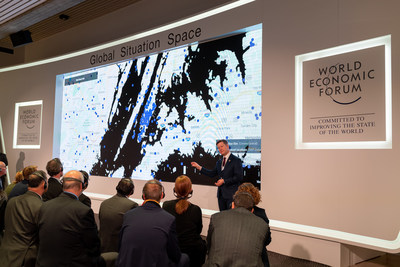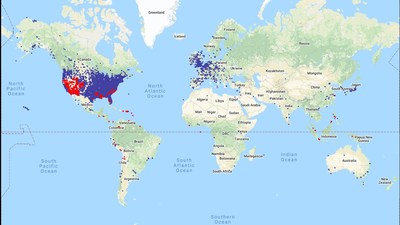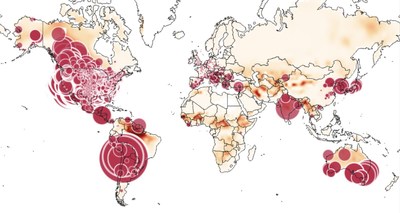

NEW YORK, Jan. 22, 2020 /PRNewswire/ -- S&P Global (NYSE: SPGI) unveiled today the "The Big Picture on Corporate Climate Risk" at the Global Situation Space during the 2020 Annual Meeting of the World Economic Forum (WEF) in Davos.

For the third consecutive year, S&P Global presented its latest data and insights through an interactive data wall as part of the official Davos program. The research examined the effects of climate change that pose important transition and physical risks for companies and investors through regulation, changing market dynamics, and technology, among other factors.
This year's presentation incorporated data from the Climate Change Physical Risk Analytics dataset from Trucost, part of S&P Global, and from S&P Global Platts, a division of S&P Global.
"The World Economic Forum at Davos provides an excellent platform to bring climate issues to the forefront of discussions between global leaders in business, politics and society, and we are proud to complement those efforts with this year's presentation," said Dr. Richard Mattison, CEO of Trucost, part of S&P Global. "Our data shows that heatwaves, wildfires, water stress, and hurricanes linked to rising average global temperatures represent the biggest physical risks for companies in the S&P 500. Furthermore, the location of assets is the key factor in determining the extent of these risks, outweighing the industry or sector in which a company operates."
The findings revealed in S&P Global's presentation at Davos show that companies in the S&P 500 Index own physical assets across 68 countries globally, while 60% of these entities (with a market capitalization of $18 trillion) hold assets that are at high risk of at least one type of climate-related physical event. Some sectors face heightened risks. For example, real estate investment trusts (REITs) included in the S&P 500 own properties across the globe with significant concentrations in the U.S., U.K., and Canada. Some of these properties are exposed to risk of inundation due to sea level rise, highlighting the need for effective planning and flood-mitigation measures to preserve asset values.
Dr. Mattison added, "These types of findings play a vital role in helping understand the financial risks associated with climate change, and in turn enable the public and private sectors to work in tandem, establish proper frameworks, and tackle the biggest issue facing our generation."
The presentation also highlights S&P Global Platts analysis that estimates adherence to historic trends would significantly increase energy-combustion CO2 emissions, while Platts' most likely scenario—taking into account expected policy action and technological innovation—envisions emissions stabilizing after around 2025. But this is still far above needed targets; Platts' 2-degree scenario would require global demand for fossil fuels to peak by 2025.
To see full coverage of S&P Global's presence at the WEF Annual Meeting at Davos, visit spglobal.com/davos2020. To learn more about S&P Global's data, insights and initiatives on climate change, visit spglobal.com/climaterisk.
About S&P Global
S&P Global is a leading provider of transparent and independent ratings, benchmarks, analytics and data to the capital and commodity markets worldwide. The Company's divisions include S&P Global Ratings, S&P Global Market Intelligence, S&P Dow Jones Indices and S&P Global Platts. S&P Global has approximately 21,000 employees in 33 countries. For more information visit www.spglobal.com.
Trucost, a part of S&P Global
Trucost is part of the S&P Global family, operated by S&P Market Intelligence. Trucost assesses and prices risks relating to climate change, natural resource constraints and broader ESG factors. Companies and financial institutions use Trucost intelligence to understand exposure to ESG factors, inform resilience and identify the transformative solutions of tomorrow. Trucost data also underpins ESG indices, including the S&P 500 Carbon Efficient Index® and -S&P/IFIC Carbon Efficient Index®. For more information, visit www.trucost.com


SOURCE S&P Global
